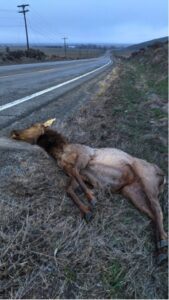BY LARRY BARNES

An elk calf was conceived during the rut of 2019 and born about June of 2020. She and her mother bonded and were seldom apart, moving with their herd through the wild and mostly public lands north of Carey and surviving her first winter, her kind’s deadliest foe. In the fall of 2020 the calf witnessed her first rut and her mother became pregnant again but still the mother watched out for her yearling daughter.
The calf’s mettle was tested over another season of long nights, snow, and poor food quality — and she passed. She and her brethren followed their wise lead cows across the land, from shrub-steppe to Douglas-fir forests and in late summer to the alpine reaches, harvesting nature’s bounty along the way while striving to avoid their mortal enemies. In the fall of 2021, the calf was an active participant in the rut, the bugling, the fighting bulls, the tension, the herd running to and fro, and the high stakes. The calf, soon to become a young mother, survived her third winter until, on March 29, 2022, when she was killed by a vehicle.
We were on our way to observe sage-grouse at a lek and changed our plans upon discovering her body, warm and supple with wet eyes and little trauma — an elk in still life on the shoulder of the road. The impact was probably to her head and we decided to salvage her. As we waited in my Jetta for help to arrive, we watched 17 members of her herd 500 yards away. Their anxious, confused, and panicked movements told a story.
Something novel and dangerous had just killed a member of their tribe here; a sort of threat that was clearly real, but new in their evolutionary history. Given the faintest sign of their ancient enemies, such as wolves and mountain lions, elk know exactly what to do. Predators have selected for elk that usually get away, being most vulnerable when young, old, injured, or sick.
Elk even survived the new superpredator that arrived in North America 20,000-30,000 years ago. Humans were like their other predators; they stalk and kill you, but humans can do so from afar. But now there are roads with wheeled, inanimate killing objects that are dangerous in strange and novel ways. And there are fences that unpredictably tangle and hold you for days until you die.
Watching over 45 minutes with binoculars from inside the car we saw the fear and indecision in the lead cow’s movements as her followers let her do all the thinking. She ran toward the road, herd in tow, stopped, and then ran back to the south. The way north toward better forage was blocked, dangerously and incomprehensibly, by two fences, a road, and automobiles. One of their elk friends, someone’s daughter, had just been killed. We watched, muttering encouragement to “go now, now” or, “no, wait, wait.”
The byzantine tangle of roads and fences that now block ancient migratory corridors were constructed here in the West in an evolutionary nanosecond of 150 years or so. It’s no wonder that anxiety and confusion are what elk and other species experience when attempting to navigate their habitat crisscrossed by roads and fences, innocuous one moment, deadly the next. It may take natural selection much more than 150 years to develop a work-a-round to these causes of mortality.
A friend with a van finally arrived and the three of us, grunting and pulling with gerryrigged straps, managed to get her 350 to 400 pounds into the cargo bay, while the friend’s dog looked on with wonder at this new development. When we opened her up, she was warm and healthy and her calf was lifeless and perfect within her. The hooves were well-formed, supple and gaining color, the chestnut spotted coat slick and clean, bathed in amniotic fluid. To the young elk mother, her child, and all wildlife, every road is a capricious toll road.
Larry Barnes retired from 26 years as a biology teacher at Wood River High School and is now transitioning to spending more time exploring the natural world.
